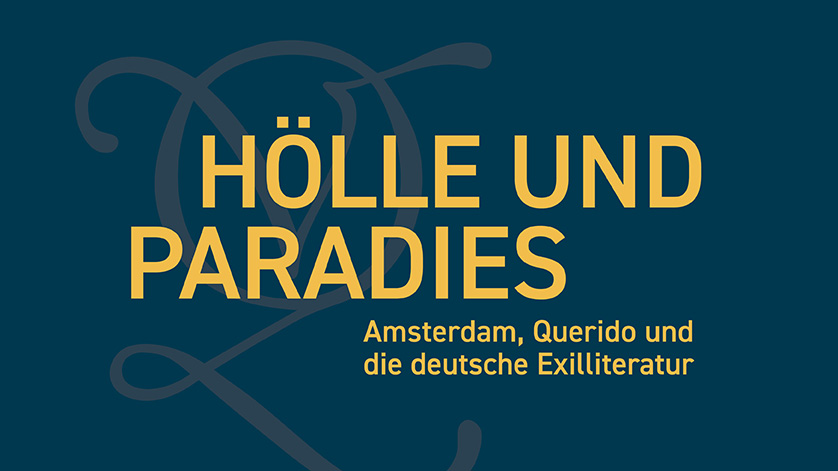Hell and paradise. Amsterdam, Querido and German exile literature
 Graphic: Tecton
Graphic: Tecton
Showcase exhibition at the German Museum of Books and Writing
20 March 2024 to 12 January 2025
When Emanuel Querido first founded a literature publishing company in Amsterdam in 1915, he had no idea that barely 20 years later, it would become a second home for Jewish authors forced to flee Germany to escape the Nazis. "Amsterdam: what a beautiful, unique city! It has become our refuge, it allows us to work," was Klaus Mann's enthusiastic comment on one of his first stops in exile. More than just a temporary home, Amsterdam soon held out the promise of a completely different kind of home: between 1933 and 1950, Querido Verlag published more than 100 books by authors who had to flee Germany to escape Nazi persecution, among them Joseph Roth, Irmgard Keun and Lion Feuchtwanger.
Scattered far and wide across Europe, the German writers found a spiritual home in Amsterdam, which not seldom secured their livelihoods as well. Querido Verlag was established by Emanuel Querido, who founded a German-language subsidiary within his publishing company in cooperation with publisher Fritz Landshoff, another exile from Germany. From April 1933, there were two publishing companies: one Dutch, the other German. And Amsterdam became a place of spiritual refuge. The last book released by the exile publisher – an anthology compiled in memory of Klaus Mann – was published in 1950. The legendary Dutch publishing house Querido was re-established in 2014.
The exhibition "Hell and Paradise" tells the story of the German publishing company Querido Verlag and the people who left their mark on it. The two publishers and their most important authors, among them Klaus Mann, Anna Seghers, Irmgard Keun, Vicki Baum, Lion Feuchtwanger and Joseph Roth, are profiled together with their texts and the stories of their exile in the Netherlands. For all of them, Querido and Amsterdam were a paradise in which the exiled writers were – at least temporarily – safe from persecution and their books were in good hands. Yet they were also a hell, since a feeling of hopelessness dominated the writers' lives. This ambivalence is explored throughout the exhibition.
The exhibition is curated by author and journalist Bettina Baltschev. It opened as part of the 2024 Leipzig Book Fair, where Flanders and the Netherlands will be the guests of honour.
To accompany the exhibition, Berenberg Verlag is publishing a new edition of "Hell and paradise. Amsterdam, Querido and German exile literature" by Bettina Baltschev https://d-nb.info/1308201362.
Information for your visit
Opening hours and admission
Tuesday to Sunday 10:00 to 18:00
Thursday 10:00 to 20:00
Public holidays 10:00 to 18:00 (except 24 to 26 December, 31 December and 1 January)
Closed on Mondays
Admission free
Guided tours
General and theme-based guided tours of our exhibitions are held on a regular basis.
To the events calendar
Group tours
You are also welchome to book group tours with us. Simply write us an e-mail:
dbsm-info@dnb.de
Accessibility
The exhibition has barrier-free access.
Address and getting here
German National Library
German Museum of Books and Writing
Deutscher Platz 1
04103 Leipzig
Getting here
We advise you to use public transport.
1 / By public transport
By rail
From the main railway station, take S-Bahn S1 in the direction of Riesa, S2 in the direction of Markkleeberg-Gaschwitz, S3 in the direction of Stötteritz or S5/S5X in the direction of Zwickau. Journey time approx. 7 minutes, get off at “Leipzig MDR”. Exit onto Semmelweisstraße, then turn right and continue for 400 m to the intersection at Straße des 18. Oktober.
Alternatively, take tram line 16 from platform 2 in front of the main railway station (in the direction of Lößnig) and get off at “Deutsche Nationalbibliothek”. Journey time approx. 11 minutes.
By air
From Leipzig/Halle airport, take S-Bahn S5/S5X in the direction of Zwickau. Journey time approx. 30 minutes, get off at “Leipzig MDR”. Exit onto Semmelweisstraße, then turn right and continue for 400 m to the intersection at Straße des 18. Oktober.
2 / By car
Approaching from the north
Take the A9 to the Schkeuditzer Kreuz intersection, continue on the A14 towards Dresden and take the Leipzig-Mitte (city centre) exit; continue on the B2 towards Leipzig city centre as far as the intersection at Prager Straße/Semmelweisstraße (follow the signs for “Deutsche Nationalbibliothek”).
Approaching from the south and east
Take the A9 or A14, change to the A38 and continue to the Leipzig-Süd exit; change to the B2 and continue to the Südvorstadt exit; turn right into Kurt-Eisner-Straße and continue to the German National Library.
3 / Accessibility
The German National Library in Leipzig has disabled parking spaces right in front of the building. The entrance for disabled visitors is signposted. The reading rooms and cafeteria are accessible by lift.
Last changes:
19.03.2024

